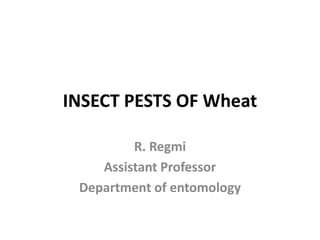Insect pest of wheat
•Télécharger en tant que PPTX, PDF•
27 j'aime•22,030 vues
Signaler
Partager
Signaler
Partager

Recommandé
Recommandé
Contenu connexe
Tendances
Tendances (20)
INTEGRATED PEST MANAGEMENT FOR INSECT PESTS OF PULSES 

INTEGRATED PEST MANAGEMENT FOR INSECT PESTS OF PULSES
Insect pest of urd, moong and gram and their management

Insect pest of urd, moong and gram and their management
important species of pollinatiors, weed killer and scavengers. ppt.pptx

important species of pollinatiors, weed killer and scavengers. ppt.pptx
Similaire à Insect pest of wheat
Similaire à Insect pest of wheat (20)
insectpestsofcucurbits-150702174843-lva1-app6891.pdf

insectpestsofcucurbits-150702174843-lva1-app6891.pdf
Entomology| pest of oil seeds|biology and management

Entomology| pest of oil seeds|biology and management
Plus de agriyouthnepal
Plus de agriyouthnepal (20)
Soil consistence - Cohesion - Adhesion - Plasticity - Atterberg’s constant - ...

Soil consistence - Cohesion - Adhesion - Plasticity - Atterberg’s constant - ...
Bulk density - Particle density - Definition - Factors affecting bulk density...

Bulk density - Particle density - Definition - Factors affecting bulk density...
Fundamentals of Soil Science (Soil formation, Structuexture)

Fundamentals of Soil Science (Soil formation, Structuexture)
Soil pH - Factors affecting soil pH - Soil pH and nutrient availability; Buff...

Soil pH - Factors affecting soil pH - Soil pH and nutrient availability; Buff...
Glimpses of ongoing research on Papaya cultivation on chitwan

Glimpses of ongoing research on Papaya cultivation on chitwan
Agri youthnepal friday sharing the_superstring_theory

Agri youthnepal friday sharing the_superstring_theory
Insect pest of wheat
- 1. INSECT PESTS OF Wheat R. Regmi Assistant Professor Department of entomology
- 2. INSECTS PESTS OF WHEAT Different insect pests attacking wheat are as follows: • Pink borer, Sesamia inferens (Lepidoptera: Noctuidae) • Wireworm, Agriotes sp (Coleoptera: Elateridae) • Armyworm, Mythimna separata (Lepidoptera: Noctuidae) • Aphids, Rhopalosiphum maidids, Schizaphis graminnum, and Microsiphium acanae (Homoptera: Aphididae) • Grasshopper, Atractomorpha crenulata, Oxya adanata, chrotogonus sp( Orthoptera: Acrididae) • Termite, Microtermes obsi, Odontotermes obsesus (Isoptera: Termitidae)
- 3. Aphid Armyworm Grasshopper Pink borer Termite
- 4. Pink borer, Sesamia inferens (Lepidoptera: Noctuidae) • The pink borer is polyphagous insect. • It feeds on wheat, finger millet, rice, sugarcane, maize, sorghoum. • The damage is caused by the caterpillars which are pinkish brown and have a smooth cylindrical body, measuring about 25mm. • The moth are straw coloured and have stout body.
- 6. Life cycle: • The pest breeds actively from March- April to November on rice and then migrates to the wheat crop. • The moth are nocturnal and lay eggs on leaves or on the ground. • The egg hatch in 6-8 days and young caterpillar bore into the epidermal layers of the leaf sheath. • Later on, they bore into the stem as a result of which the growing shoot dries up producing dead hearts. • When the attacked plants die, the larva move onto adjoining plants. • They are full fed in 3-4 weeks and pupate inside the stem or in between the stem and leaves. • The pupal stage last about a week and the life cycle is completed in 6-7 weeks. • There are 4-5 generations of the pest in a year.
- 8. Damage: • The attacked young plants shows dead hearts and are killed together. • The older plants are not killed, but they produce a few grains only.
- 9. Management: • The removal and destruction of stubble at the time of the first ploughing after harvesting the crop. • Ploughing and flooding the field is also effective in killing the larvae • Clipping of tips of seedling before transplanting can reduce the carryover of eggs to the field • Use trichocard with 50,000-1,00,000 trichogramma per ha • The field showing more than 5% dead hearts should be sprayed with 875 ml triazophos 40 EC or 2.5 liters of chlorpyriphos 20EC in 250 liter of water per ha.
